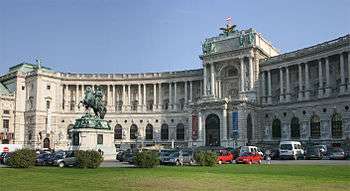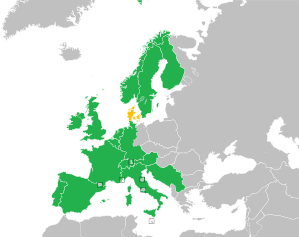Eurovision Song Contest 1967
| Eurovision Song Contest 1967 | |
|---|---|
 | |
| Dates | |
| Final | 8 April 1967 |
| Host | |
| Venue |
Großer Festsaal der Wiener Hofburg Vienna, Austria |
| Presenter(s) | Erica Vaal |
| Conductor | Johannes Fehring |
| Directed by | Herbert Fuchs |
| Executive supervisor | Clifford Brown |
| Host broadcaster | Österreichischer Rundfunk (ORF) |
| Interval act | The Blue Danube by Wiener Sängerknaben |
| Participants | |
| Number of entries | 17 |
| Debuting countries | None |
| Returning countries | None |
| Withdrawing countries |
|
|
Participation map
| |
| Vote | |
| Voting system | Ten-member juries distributed ten points among their favourite songs. |
| Nul points | |
| Winning song |
"Puppet on a String" |
The Eurovision Song Contest 1967 was the 12th edition of Eurovision Song Contest. It took place on 8 April 1967 in Vienna, Austria following Udo Jürgens win at the 1966 contest. The presenter was Erica Vaal.
The winning entry "Puppet on a String", sung by Sandie Shaw, representing the United Kingdom, had one of the widest margins of victory ever witnessed in the competition; it garnered more than twice as many points as the second placed song. (Only Italy, in the 1964 contest, beats this record with a margin of 47 to 17, almost three times as many points). The presenter became confused whilst the voting was taking place, and declared the United Kingdom's entry to be the winner before the last country, Ireland, had announced its votes. Shaw intensely disliked the composition, though her attitude towards the song somewhat mellowed in later years, even releasing a new version in 2007.[1]
The contest long remained the only time Austria had hosted the event, until 2015.
Location

The 1967 Eurovision Song Contest was held in Vienna, the capital of Austria. The venue for the contest was the Hofburg Palace, which was the principal winter residence the Habsburg dynasty, rulers of the Austro-Hungarian empire.[2] It currently serves as the official residence of the President of Austria.
Format
The stage setup was a little bit unusual this year. There were two revolving mirrored walls on both ends of the stage and started revolving at the start of each song and stopped revolving at the end of each song. The hostess, Erika Vaal ended the program by congratulating the winning song, country and saying good bye in several different languages.[1] This was the last contest to be transmitted only in black and white.
Participating countries
The entry from Luxembourg, "L'amour est bleu", sung by Vicky Leandros, came in fourth; nonetheless, it went on to become the biggest international hit of the 1967 contest, and a year later would be a big instrumental hit for French musician, Paul Mauriat, under the English title, "Love is Blue". Denmark chose not to participate and left the contest at this point, to return in 1978. The reason was that the new director for the TV entertainment department at DR thought that the money could be spent in a better way.[1]
The United Kingdom's win was their first. Television presenter, artist and musician, Rolf Harris provided the commentary for BBC Television viewers. Switzerland received zero votes for the second time. Portugal was represented by Eduardo Nascimento who was the first black male singer in the history of Eurovision Song Contest, performing "O vento mudou" ("The wind changed"). Rumours claimed that Portuguese prime minister Salazar had chosen this particular singer to show the rest of Europe that he wasn't racist.[1]
Conductors
Each performance had a conductor who maestro the orchestra.[3]
|
|
|
Returning artists
Three artists returned in this year's contest. Claudio Villa from Italy whose previous participations were in 1962; and Kirsti Sparboe from Norway, who last participated in 1965; and Raphael for Spain who last represented the Iberian nation in 1966.[1]
Results
Scoreboard
| Results | ||||||||||||||||||||
|---|---|---|---|---|---|---|---|---|---|---|---|---|---|---|---|---|---|---|---|---|
| Netherlands | 2 | 1 | 1 | |||||||||||||||||
| Luxembourg | 17 | 4 | 2 | 1 | 2 | 1 | 1 | 1 | 3 | 2 | ||||||||||
| Austria | 2 | 1 | 1 | |||||||||||||||||
| France | 20 | 1 | 2 | 1 | 1 | 4 | 2 | 2 | 2 | 4 | 1 | |||||||||
| Portugal | 3 | 1 | 1 | 1 | ||||||||||||||||
| Switzerland | 0 | |||||||||||||||||||
| Sweden | 7 | 1 | 1 | 2 | 1 | 2 | ||||||||||||||
| Finland | 3 | 1 | 1 | 1 | ||||||||||||||||
| Germany | 7 | 1 | 1 | 1 | 1 | 1 | 1 | 1 | ||||||||||||
| Belgium | 8 | 1 | 3 | 1 | 1 | 1 | 1 | |||||||||||||
| United Kingdom | 47 | 2 | 5 | 3 | 7 | 1 | 7 | 1 | 2 | 3 | 3 | 7 | 3 | 2 | 1 | |||||
| Spain | 9 | 1 | 1 | 1 | 2 | 1 | 2 | 1 | ||||||||||||
| Norway | 2 | 1 | 1 | |||||||||||||||||
| Monaco | 10 | 2 | 1 | 1 | 5 | 1 | ||||||||||||||
| Yugoslavia | 7 | 1 | 1 | 1 | 1 | 2 | 1 | |||||||||||||
| Italy | 4 | 1 | 1 | 1 | 1 | |||||||||||||||
| Ireland | 22 | 1 | 3 | 1 | 2 | 2 | 4 | 3 | 2 | 2 | 1 | 1 | ||||||||
International broadcasts and voting
The table below shows the order in which votes were cast during the 1967 contest along with the spokesperson who was responsible for announcing the votes for their respective country. Each national broadcaster also sent a commentator to the contest, in order to provide coverage of the contest in their own native language. Details of the commentators and the broadcasting station for which they represented are also included in the table below.[1]
| Voting order | Country | Spokespersons | Commentator | Broadcaster |
|---|---|---|---|---|
| 01 | Ellen Blazer | Leo Nelissen | Nederland 1[5] | |
| 02 | TBC | Jacques Navadic | Télé-Luxembourg | |
| 03 | Walter Richard Langer | Emil Kollpacher | ORF | |
| 04 | Jean-Claude Massoulier[6] | Pierre Tchernia | Première Chaîne ORTF[7] | |
| 05 | Maria Manuela Furtado | Henrique Mendes | RTP | |
| 06 | Alexandre Burger | Theodor Haller | TV DRS | |
| Georges Hardy | TSR | |||
| Giovanni Bertini | TSI | |||
| 07 | Edvard Matz[8] | Christina Hansegård | Sveriges Radio-TV and SR P3[9] | |
| 08 | Poppe Berg | Aarno Walli | TV-ohjelma 1 and Yleisohjelma[10] | |
| 09 | Lia Wöhr | Hans-Joachim Rauschenbach | ARD Deutsches Fernsehen[11] | |
| 10 | Ward Bogaert | Herman Verelst | BRT | |
| Janine Lambotte | RTB | |||
| 11 | Michael Aspel | Rolf Harris | BBC 1 | |
| Richard Baker | BBC Light Programme | |||
| 12 | Margarita Nicola | Federico Gallo | TVE1 | |
| 13 | Sverre Christophersen[12] | Erik Diesen | NRK and NRK P1 | |
| 14 | TBC | Pierre Tchernia | Télé Monte Carlo | |
| 15 | TBC | Miloje Orlović | Televizija Beograd | |
| Mladen Delić | Televizija Zagreb | |||
| Tomaž Terček | Televizija Ljubljana | |||
| 16 | Mike Bongiorno | Renato Tagliani | Secondo Programma | |
| 17 | Gay Byrne | Brendan O'Reilly | RTÉ Television | |
| Kevin Roche | Radio Éireann |
References
- 1 2 3 4 5 6 "Eurovision Song Contest 1967". EBU. Retrieved 15 June 2012.
- ↑ Aeiou-Hofburg-English, "Hofburg, Wien" (history), Encyclopedia of Austria, Aeiou Project, 2006.
- ↑ "Conductors 1967". 4Lyrics.com. Retrieved 15 June 2012.
- ↑ "Eurovision Song Contest 1967". The Diggiloo Thrush. Retrieved 4 March 2012.
- ↑ "Nederlandse televisiecommentatoren bij het Eurovisie Songfestival". Eurovision Artists (in Dutch).
- ↑ Tchernia, Pierre et al. (April 8, 1967). 11ème Concours Eurovision de la Chanson 1967 [11th Eurovision Song Contest 1967] (Television production). Austria: ORF, ORTF (commentary).
- ↑ Christian Masson. "1967 – Vienne". Songcontest.free.fr. Retrieved 2012-08-10.
- ↑ "Infosajten.com". Infosajten.com. Archived from the original on 18 July 2012. Retrieved 2012-08-10.
- ↑ Leif Thorsson. Melodifestivalen genom tiderna ["Melodifestivalen through time"] (2006), p. 66. Stockholm: Premium Publishing AB. ISBN 91-89136-29-2
- ↑ "The Eurovision Song Contest". 8 April 1967 – via IMDb.
- ↑ "Tag – TV-Programme". www.tvprogramme.net.
- ↑ Dyrseth, Seppo (OGAE Norway)
External links
| Wikimedia Commons has media related to Eurovision Song Contest 1967. |
Coordinates: 48°12′23″N 16°21′55″E / 48.206507°N 16.365262°E

